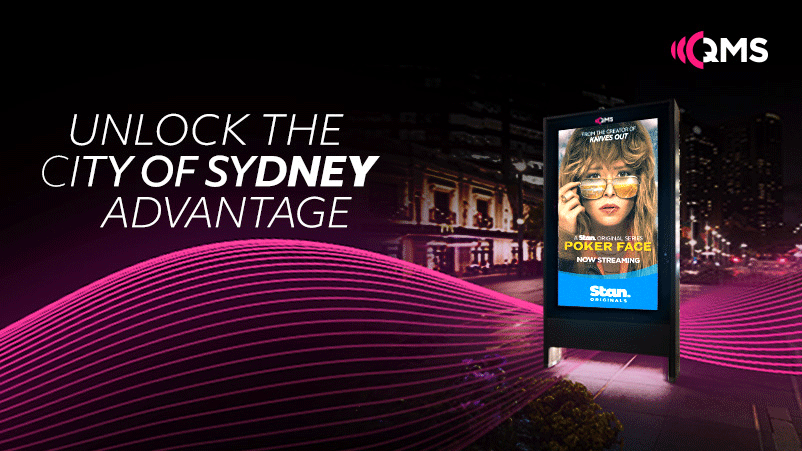New City of Sydney network 26% more effective for brands: Neuroscience proves QMS’ digitised OOH rollout is delivering sharper results

Exploring how specific features within out-of-home formats change a consumer’s response, a new study from Neuro-Insight with QMS set out to unlock how the new City of Sydney digital street furniture network impacts consumers.
A Neuro-Insight study with QMS benchmarks how specific features within out-of-home formats change consumer responses, the uplift in effectiveness for brands and how the new City of Sydney network compares to the old assets. Peter Pynta, Global CCO at Neuro-Insight, unpacks the key findings – and what they mean for marketers.
Understanding the effectiveness and advantage of any new media asset continues to be a critical consideration for marketers and agencies faced by downward pressures on return on investment, ease of buying and of course time.
Faced by new and nuanced audience behaviours in our major cities, how does digital OOH’s design, amenity and digital campaign capability contribute to a brand’s memory encoding, desirability - and ultimate consumer behavioural change?
For the first time, Neuro-Insight applied consumer neuroscience to understand how a consumer journey changes and evolves over time. Exploring how specific features within out-of-home formats change a consumer’s response, a new study with QMS set out to unlock how the new City of Sydney digital street furniture network impacts consumers. It’s fair to say it became a fascinating project to design and then execute.
The study:
From the start, this project was unique and unusually large in size, scope, time and planning. We used the standard “consumer journey” approach that has been used globally as Neuro-Insight’s benchmark OOH stimulus approach. But this project required an important and unusual addition: the identical journey needed to be replicated one year later to zero-in on the differences between the old and new City of Sydney assets. A representative range, routes and number of sites were evaluated to ensure that individual ads were not driving or skewing the results in either of the two waves.
At its heart, the study set out to understand the impact and effectiveness of the QMS City of Sydney digital street furniture network. It revealed that long-term memory encoding, a metric shown to drive consumer behaviour change, and desirability – a metric associated with product choice and selection – were above our global Neuro-Insight benchmarks. But to drill a little deeper, let’s explore what the results really showed us.
The results: Effectiveness and memory encoding
When evaluating the results of the QMS City of Sydney formats across the whole experience (or consumer journey), we found that the long-term memory encoding response was on average 24 per cent stronger than the Neuro-Insight benchmark across all the QMS assets. In other words, even before the old versus new network comparisons are made, we discovered that these assets drive a strong memory encoding response in their own right.
Next, when we compared the new QMS sites to the previous network, we found that the new assets were 26 per cent more effective (using Neuro-Insight’s memory Encoding metric).
The results: Engagement and emotional intensity
While memory encoding is the leading advertising effectiveness metric, the data also pointed to some broader findings on engagement and emotional intensity, measures that are typically associated with the emotional context of ad effectiveness. Both engagement and emotional intensity were 11 per cent stronger across all of the new QMS assets compared to the old network.
The results: Desirability
In creating this project, it was clear that QMS had a strong focus on – and had made a significant investment in – the design and aesthetic properties of its City of Sydney network. In consulting with QMS, Neuro-Insight recommended that an additional project would be worth including alongside the straight comparison approach. This component was much more akin to Neuro-Insight’s new product development evaluation, a completely different project design that can measure “desirability” of a product.
The measure of desirability reveals the emotional appeal of a physical item (or product). In other words, from a consumer’s unconscious perspective, it’s an insight into a response that helps unlock powerful dimensions that are associated with choice, selection, attainability and the future possession of an item. It has previously been used to help guide new product packaging and design choices, including the packaging of FMCG products, automotive interior colours and magazine covers. Generally, the stimulus has been a computer-generated 3D image of an item. In this context, we looked at typical real life formats in the City of Sydney network.
This research was unique in the out of home industry and the results were fascinating. We found that the desirability of QMS’ City of Sydney assets was 23 per cent stronger than the global Neuro-Insight benchmark. It was a strong outcome and one that should give QMS and the City of Sydney network designers validation of the immediate appeal of these new assets. It also represents a unique and compelling insight for advertisers
Summary
While we have scientifically captured important aspects of advertising effectiveness on the City of Sydney formats, this approach has significant implications for out of home format design and development in general. It also quantifies the rich emotional territory of measuring and understanding the “public amenity” of out of home structures and spaces. At the end of the day, advertisers now have robust data and scientific evidence to know that even in a challenging media landscape, QMS’ City of Sydney network can help ensure they stand out and deliver real results.
